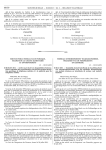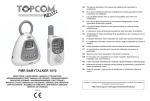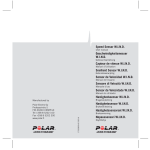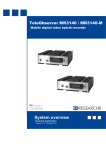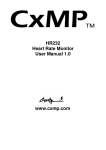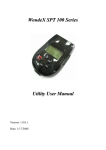Download New rules for selling mobile phones
Transcript
New rules for selling mobile phones
Practical guide for sellers and distributors
I.
Measures ........................................................................................................................ 2
1.
What are the exact implications of the measures? ..................................................................................... 2
2.
Why were these measures taken? .............................................................................................................. 2
3.
What is the purpose of these measures? .................................................................................................... 2
4.
Who will control the implementation of these Royal Decrees and what kind of penalties are foreseen for
offenders? ............................................................................................................................................................. 3
II. SAR in the shop and in e-commerce ................................................................................. 3
5.
To which phones do these new rules apply? ............................................................................................... 3
6.
What is SAR and as a salesman, where can I find the values? .................................................................... 3
7.
There are several SAR values for the same phone; which should I take? ................................................... 4
8.
How should the SAR value be displayed? .................................................................................................... 4
9.
Which category for which SAR?................................................................................................................... 5
10.
Should I provide an explanation for the categories A-E? ............................................................................ 5
11.
Should the SAR value be displayed on the packaging? ............................................................................... 6
12.
Are foreign e-commerce websites supposed to comply with the new rules? ............................................ 6
III. Advertising...................................................................................................................... 6
13.
What does advertising entail? ..................................................................................................................... 6
14.
How about a promotional display made from mobile phone boxes in a store? ......................................... 7
15.
May young children be confronted with adverts targeting older children or adults? ................................ 7
16. What if a brochure contains advertising for various age groups, such as a mobile phone for teenagers
and toys for the smallest children (e.g. a toy brochure for Christmas)? .............................................................. 7
IV. Ban on selling mobile phones for children ........................................................................ 7
17.
Which mobile phones for children are banned? ......................................................................................... 7
18.
Which mobile phones for children may still be sold? .................................................................................. 8
I.
Measures
1.
What are the exact implications of the measures?
As from 1 March 2014, the radiation value (SAR value1) of all types of mobile phones (GSM
mobile phone or smartphone) must be indicated by the seller:
a. at the point of sale and for distance sales, through the internet;
b. in advertising materials, if other technical specifications are included also.
Manufacturers, importers and distributors offering mobile phones on the Belgian market will
have an obligation to communicate the SAR value to their buyers, so that the latter can display
it at the point of sale.
Furthermore, a ban is imposed on selling mobile phones designed for children under the age of
7, as well as on advertising materials encouraging the use of mobile phones by this age group.
These measures have been introduced in the form of two Royal Decrees2, published on 30
August 2013.
Top
2.
Why were these measures taken?
Certain studies indicate the possibility of an increased risk of brain cancer from intensive use of
mobile phones. For this reason, the International Agency for Research on Cancer (a World
Health Organisation agency) has classified electromagnetic fields produced by mobile phones as
"possibly carcinogenic to humans". Pending the availability of more specific scientific
conclusions, the Belgian government has deemed it necessary to take precautionary measures.
Top
3.
What is the purpose of these measures?
The measures aim at allowing consumers to take the SAR-value into account when choosing a
mobile phone. Said value, which in the scope of the EU conformity evaluation procedure (when
placing a product on the market) has to be measured for every mobile phone, is currently made
available on producers’ websites and in their technical documentation. Making the value
available in the shop makes it easier for the consumer to take it into consideration when
deciding on the purchase of a mobile phone.
Prohibiting advertising targeting young children and a ban on mobile phones designed for
young children is meant to reduce the offer as well as the demand for mobile phones in this
user category.
Top
1
Specific Absorption Rate
Royal Decree of 30 July 2013 concerning the prohibition of placing on the market any mobile phones specifically designed for
young children; Royal Decree of 30 July 2013 concerning the availability of consumer information about the Specific Absorption
Rate of mobile telephones and concerning the advertising for mobile telephones.
2
2
4.
Who will control the implementation of these Royal Decrees and what kind of penalties
are foreseen for offenders?
The implementation of these decrees will be checked by the control officers of the Federal
Public Services (FPS) for both Health and Economy. In first instance, offenders will receive a
warning. Repeat offenders will be facing other measures, such as a fine. Procedures and fines
may vary depending on the violation. For instance: offenders who do not communicate the SAR
value may incur a fine between EUR 52 and EUR 120,000. This amount will be multiplied by a
surcharge amount (which in practice comes down to multiplication by 6).
Top
II.
SAR in the shop and in e-commerce
The SAR value of mobile phones must be indicated at the point of sale, including distance sales
(e.g. via the Internet). A letter A, B, C, D or E must be added to the SAR value as an indication of
the category to which it belongs. An explanation of the categories must be included also,
together with the statement "Think about your health...", as specified under question 10.
Top
5.
To which phones do these new rules apply?
The new rules apply to GSM mobile phones and smartphones. They do not apply to portable
home phones (e.g. DECT), walkie-talkies, tablets or professional radio equipment.
Top
6.
What is SAR and as a salesman, where can I find the values?
SAR (Specific Absorption Rate) is the radiation rate of mobile phones; more specifically, it is the
level of exposure of the user to the radio waves generated by a mobile phone. The SAR value
indicates the speed at which the energy of radio waves is absorbed by the human body. There
are different SAR values for the head and for the body.
In Dutch the value is known by the abbreviation SAT (Specifiek AbsorptieTempo); the French
refer to it as DAS (Débit d’Absorption Spécifique); in German it is called SAR (“Spezifische
Absorptionsrate”).
SAR values are known to the manufacturers of mobile phones. After all, manufacturers are
obligated to measure the SAR value for each device prior to placing it on the market (to ensure
that it does not exceed the limit of 2 W/kg).
For the exact SAR value of any mobile phone you should first ask your supplier. They have a
legal obligation of providing information on SAR values to their customers.
3
In addition, the SAR value of a device can be found
in the user manual of the device;
on the website of the manufacturer;
on the website of the Mobile Manufacturers Forum, www.mmfai.org.
Top
7.
There are several SAR values for the same phone; which should I take?
You may find more than one SAR value for mobile phones that are manufactured outside the
European Union, e.g. an American SAR value next to the European SAR value. These values
differ because they are measured in different ways.
In some cases the information contains a value for the head as well as for the body.
You should refer only to the European value for the head: this is the only value that must be
specified for selling and promotional purposes.
Products whose European SAR value is not known to the manufacturer may not be sold on the
European market.
Top
8.
How should the SAR value be displayed?
The SAR value must be indicated next to every mobile phone model, e.g. on the price label, in
the list of technical specifications, such as network, memory, etc.
The SAR value is expressed in watts per kilogram (W/kg), preceded by the abbreviation SAR.
Values are displayed with one digit after the decimal point and rounded off as follows: 0.45
becomes 0.5; 0.44 becomes 0.4. A letter (A, B, C, D or E) is added next to the SAR value and
indicates the SAR classification. The font size should not be smaller than the largest font size
used for the other technical specifications of the product.
4
Mobile phone
Label
Brand X Model Y
Brand X model Y
SAR = 0.218 W/kg
Price: EUR XX
Talk time: 10 hours
Camera: VGA
Bluetooth 3.0
SAR: 0.2 W/kg (A)
Brand X Model Y
Brand A model C
SAR = 0.562 W/kg
Price: EUR XX
Talk time: 18 hours
Wi-Fi
Camera: 8 megapixels
SAR: 0.6 W/kg (B)
Top
9.
Which category for which SAR?
Mobile phones with the lowest SAR values are in category A; those with the highest SAR values
are categorised as E.
-
A: SAR < 0.4 W/kg,
B: 0.4 ≤ SAR < 0.8 W/kg,
C: 0.8 ≤ SAR < 1.2 W/kg,
D: 1.2 ≤ SAR < 1.6 W/kg,
E: 1.6 ≤ SAR ≤ 2 W/kg.
Top
10. Should I provide an explanation for the categories A-E?
Yes, you have a legal obligation to provide a legible poster in a visible place containing an
explanation of the A, B, C, D and E SAR categories, together with the following notification:
"Think about your health – use your mobile phone moderately, make your calls wearing
an earpiece and choose a set with a lower SAR value".
5
The text reads as follows in Dutch, French and German, respectively:
"Denk aan uw gezondheid – gebruik uw mobiele telefoon met mate, bel met een oortje
en kies voor een toestel met een lagere SAT-waarde (SAR-waarde)";
"Pensez à votre santé – utilisez votre téléphone portable avec modération, privilégiez
l’usage d’une oreillette et choisissez un appareil ayant une valeur DAS (SAR) faible";
"Denken Sie an Ihre Gesundheit – Verwenden Sie Ihr Mobiltelefon in Maßen, verwenden
Sie ein Headset und wählen Sie ein Gerät mit niedrigem SAR-Wert".
Top
Should the SAR value be displayed on the packaging?
No, the Royal Decree does not apply to the packaging of mobile phones.
11.
12. Are foreign e-commerce websites supposed to comply with the new rules?
According to the rules of the European Directive 2000/31/EC ("E-Commerce Directive”), only
Belgian companies have an obligation to observe the mandatory display of the SAR value in
online sales of and online advertising for mobile telephones.
Companies established in other European member states or Iceland, Liechtenstein and Norway,
are not bound by the Belgian rules for displaying information about SAR values in online sales
of, and online advertising for mobile phones; not even if they specifically target Belgian
consumers.
However, online sales in the Belgian territory of mobile phones specifically designed for young
children is prohibited for both Belgian and foreign companies.
Top
III.
Advertising
SAR in advertising
The SAR value must be displayed in advertising for mobile phones (together with the other
technical specifications, if provided). It is also mandatory to display the explanation about the A,
B, C, D and E categories in relation to the SAR value, together with the health statement (one
single mention in the advertising leaflet or on the website – legible and visible).
Ban on advertising for mobile phone use by young children
Ads promoting the use of mobile phones by young children under the age of 7 are prohibited,
i.e. any advertising in children's programmes on radio and television, on websites, in children's
magazines or any other print work, etc., aiming at this target group.
13. What does advertising entail?
According to the Law on Market Practices and Consumer Protection of 6 April 2010, advertising
is "any public statement by a company with the direct or indirect purpose of promoting the sale
of products, irrespective of the communication media used". Advertising is, for example:
6
commercials on radio or television; posters on billboards; banners on internet pages;
promotional films in cinema's; adverts in newspapers and magazines, on trams, buses, taxis,
cars, etc.
The Royal Decree does not apply to all advertising involving mobile phones: only if the advert
mentions the technical specifications of a mobile phone does the SAR value have to be
displayed (next to the A, B, C, D or E category and the caution on usage).
Top
14. How about a promotional display made from mobile phone boxes in a store?
The Royal Decree does not apply to the packaging of mobile phones. Even if the packaging is
used in the store to draw the attention of consumers, it does not have to display the SAR value.
Placing the SAR value on the label next to the model on display – together with the technical
specifications – is enough.
Top
15. May young children be confronted with adverts targeting older children or adults?
The Royal Decree prohibits advertising specifically targeting young kids. Advertisements in an
age-neutral or adult context do not fall within the scope of this Royal Decree.
Top
16.
What if a brochure contains advertising for various age groups, such as a mobile phone
for teenagers and toys for the smallest children (e.g. a toy brochure for Christmas)?
The Royal Decree does not prohibit advertising aimed at older age groups. However, it is not
allowed to use such brochures for the promotion of mobile phones specifically in connection
with young children, for instance through a picture of a young child with a mobile phone.
Top
IV.
Ban on selling mobile phones for children
A ban is imposed on mobile phones designed specifically for children under the age of 7.
17. Which mobile phones for children are banned?
The definition "mobile phones for young children" encompasses any mobile phone that has
been made enticing for children under the age of 7, or that has been declared by the
manufacturer as specifically designed for this age group.
It includes mobile phones that look like toys due to their playful design, simple operation and
minimum set of keys.
7
Below are a few examples of mobile phones that are now banned:
Top
18. Which mobile phones for children may still be sold?
The mobile phones shown below may still be sold. They are in fact normal mobile phones but
with a playful design, made for older children.
Top
The mobile phone for elderly people shown below does not have a playful design, but is
nevertheless easy to operate and could be used by young children. This mobile phone is also
suitable for other users who need a phone that is easy to operate. This mobile phone is not
specifically meant for young children and therefore may be placed on the market.
Selling walkie-talkies for children is allowed: they fall outside the scope of the Royal Decree.
Top
Image sources: Samsung, Kidstel gsm tracker, Sitcon, KaKatech
8











